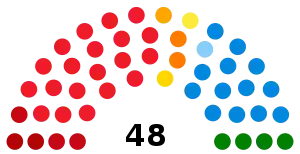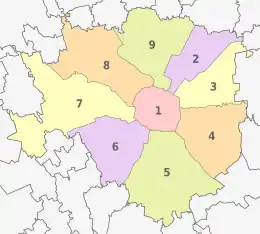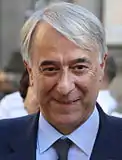2011 Milan municipal election
Municipal elections were held in Milan on 15–16 and 29–30 May 2011, at the same time as Italian local elections.
| |||||||||||||||||||||||||
| Turnout | 67.6% (first round) 67.4% (second round)[1] | ||||||||||||||||||||||||
|---|---|---|---|---|---|---|---|---|---|---|---|---|---|---|---|---|---|---|---|---|---|---|---|---|---|
| |||||||||||||||||||||||||
| |||||||||||||||||||||||||
The incumbent Mayor of Milan, Letizia Moratti, was defeated by the center-left candidate Giuliano Pisapia.
Councillors and presidents of the 9 administrative zones of the city were also to be decided in the elections. Of these, the center-left coalition controlled one and the center-right eight. 48 councillors were due to be elected in the City Council.
As a result of the election, Pisapia was elected on the second round becoming the first leftist mayor of Milan after nearly 20 years. The center-left coalition gained control of 29 seats in the City Council.[2]
Background
Center-left primary election
In June 2010, Pisapia was the first to submit his own nomination as the Mayor of Milan, for the elections that would take place the following year. A number of intellectuals and notable people from the cultural and political elite of Milan immediately expressed their support of Pisapia.
On 14 November 2010 he ran for the open primary election of the center-left coalition led by the Democratic Party, with the support of Nichi Vendola's Left Ecology Freedom, and unexpectedly won (receiving 45% preferences) despite not being an actual member of the PD.[3]
| Candidate | Supporting party | votes (%) |
|---|---|---|
| Giuliano Pisapia | SEL | 45.36 |
| Stefano Boeri | PD | 40.16 |
| Valerio Onida | Nonpartisan | 13.41 |
| Michele Sacerdoti | Nonpartisan | 1.07 |
Total voters: 67,499
Campaign
At the beginning of the campaign, incumbent Mayor Letizia Moratti was thought to be largely advantaged, especially as Milan is traditionally a right-wing stronghold, the homeland of Silvio Berlusconi's party (to which Moratti belongs), as well as a symbol of the alliance between Berlusconi and Umberto Bossi's Lega Nord, a party that promotes a greater independence of Northern Italy. Both Bossi and Berlusconi repeatedly declared that the left wing had no chance to win the elections in Milan, and Berlusconi himself actively contributed in the campaign, possibly to reaffirm his appeal to the Italian people leveraging on the results of what was supposed to be an easy match.[4] Berlusconi warned that if Moratti was defeated, Milan would become a "Gypsytown" and an "Islamic city".[5] The Milan Islamic Center criticized these remarks.[6]
As Berlusconi had recently been involved in a number of controversial matters, including the so-called Ruby Gate, many observers described the elections in Milan as a poll that would assess the popular support of Berlusconi's politics.[4] This attracted much attention to this particular election (one of many administrative elections held in the same days in several locations in Italy).
Voting system
The voting system is used for all mayoral elections in Italy of cities with a population higher than 15,000. Under this system voters express a direct choice for the mayor or an indirect choice voting for the party of the candidate's coalition. If no candidate receives at least 50% of votes, the top two candidates go to a second round after two weeks. This gives a result whereby the winning candidate may be able to claim majority support, although it is not guaranteed.
For zones the voting system is the same, not referred to the mayor but to the president of the zone.
The election of the City Council is based on a direct choice for the candidate with a preference vote: the candidate with the majority of the preferences is elected. The number of the seats for each party is determined proportionally.
Parties and candidates
This is a list of the major parties (and their respective leaders) which participated in the election.
| Political party or alliance | Constituent lists | Candidate | ||
|---|---|---|---|---|
| Democratic Party | ||||
| Left Ecology Freedom | ||||
| Italy of Values | ||||
| Federation of the Left | ||||
| Italian Radicals | ||||
| Federation of the Greens | ||||
| The People of Freedom | ||||
| Lega Nord | ||||
| The Right | ||||
| I Love Italy | ||||
| The Populars of Italy Tomorrow | ||||
| Alliance of the Centre | ||||
| New Pole for Italy | ||||
| Union of the Centre | ||||
| Five Star Movement | ||||
Results


In the first round of elections, on 15–16 May 2011, Pisapia got 48% of the votes and Moratti 41%. As none of them exceeded 50%, a second face-to-face round was scheduled for 29–30 May. This first success of Pisapia was one of a number of successes of the left wing in several other cities and provinces. With the campaign reaching ever harsher tones than before, Pisapia finally won on 30 May, with 55% of the votes.[7] Internet and social networks played a relevant role in the election of Pisapia.[8][9][10]
The candidate of Beppe Grillo's party Five Star Movement, Mattia Calise, who was only 20 years old, obtained nearly 3.5% of the votes.
| Candidate | Party or Coalition | First round | Second round | |||
|---|---|---|---|---|---|---|
| Votes | % | Votes | % | |||
| Giuliano Pisapia | Centre-left (SEL) | 315,862 | 48.00 | 365,657 | 55.10 | |
| Letizia Moratti | Centre-right (PdL) | 273,401 | 41.60 | 297,874 | 44.90 | |
| Manfredi Palmeri | New Pole (UDC) | 36,471 | 5.54 | |||
| Mattia Calise | M5S | 21,228 | 3.43 | |||
| Giancarlo Pagliarini | LP | 4,229 | 0.64 | |||
| Marco Mantovani | FN | 2,366 | 0.35 | |||
| Carla De Albertis | Independent | 1,804 | 0.27 | |||
| Elisabetta Fatuzzo | PP | 1,613 | 0.24 | |||
| Fabrizio Montuori | PCdL | 405 | 0.06 | |||
| Eligible voters | 996,400 | 100.0 | 996,400 | 100.0 | ||
| Did not vote | 322,875 | 32.4 | 324,980 | 32.6 | ||
| Voted | 673,525 | 67.6 | 671,420 | 67.4 | ||
| Blank or invalid ballots | 15,838 | 2.4 | 7,889 | 1.2 | ||
| Total valid votes | 657,687 | 97.6 | 663,531 | 98.8 | ||
Summary of the 2011 Milan City Council election results
 | ||||||
| Parties and coalitions | Votes | % | Seats | |||
|---|---|---|---|---|---|---|
| Democratic Party (Partito Democratico) | PD | 170,551 | 28.6% | 20 | ||
| Left Ecology Freedom (Sinistra Ecologia e Libertà) | SEL | 28,016 | 4.7% | 3 | ||
| Communist Refoundation Party (Rifondazione Comunista) | PRC | 18,467 | 3.1% | 2 | ||
| Italy of Values (Italia dei Valori) | IdV | 15,145 | 2.5% | 1 | ||
| Italian Radicals (Radicali Italiani) | RI | 10,215 | 1.7% | 1 | ||
| Others | 39,100 | 6.5% | 2 | |||
| Pisapia coalition (Centre-left) | 281,494 | 47.3% | 29 | |||
| People of Freedom (Il Popolo della Libertà) | PdL | 171,222 | 28.7% | 12 | ||
| Lega Nord | LN | 57,403 | 9.6% | 4 | ||
| The Right (La Destra) | LD | 1,721 | 0.3% | 0 | ||
| Others | 27,431 | 4.6% | 1 | |||
| Moratti coalition (Centre-right) | 257,777 | 43.3% | 17 | |||
| New Pole for Italy (Nuovo Polo per l'Italia) | NP-UDC | 27,328 | 4.6% | 1 | ||
| Five Star Movement (Movimento Cinque Stelle) | M5S | 20,438 | 3.4% | 1 | ||
| Others | 8,548 | 1.4% | 0 | |||
| Total | 595,585 | 100% | 48 | |||
| Votes cast / turnout | 673,185 | 67.1% | ||||
| Registered voters | 996,400 | |||||
| Source: Ministry of the Interior | ||||||
According to each part's popular vote, the People of Freedom party (PdL) won a narrow victory over the center-left Democratic Party (PD), which however won the majority in the City Council.
Results by zona

After the 2006 election, 8 zone were governed by the center-right and only one by the center-left. Then all were gained by the center-left coalition.[2]
| Zone | Centre-left | Centre-right | Others | Elected President | Party |
|---|---|---|---|---|---|
| 1 | 47.3 | 44.9 | 7.8 | Fabio Luigi Arrigoni | PD |
| 2 | 45.8 | 43.5 | 10.7 | Mario Villa | PD |
| 3 | 49.5 | 39.4 | 11.1 | Renato Sacristiani | PRC |
| 4 | 48.8 | 40.8 | 9.4 | Loredana Bigatti | PD |
| 5 | 48.2 | 40.1 | 11.1 | Aldo Ugliano | PD |
| 6 | 49.1 | 39.8 | 11.1 | Gabriele Rabaiotti | PD |
| 7 | 45.6 | 42.4 | 12 | Fabrizio Tellini | IdV |
| 8 | 48.1 | 40.9 | 11.0 | Simone Zambelli | SEL |
| 9 | 49.3 | 40.3 | 10.4 | Beatrice Uguccioni | PD |
Notes
- Ministry of the Interior
- http://www.comune.milano.it/dseserver/statistica/bancadatielettorale/consultazione.html
- Teresa Montestiroli (November 14, 2010). "Primarie a Milano, Pisapia batte Boeri". La Repubblica. Retrieved May 30, 2011.
- Elisabetta Polovedo (May 11, 2011). "Berlusconi makes election in Milan all about him". The New York Times. Retrieved May 30, 2011.
- "Silvio Berlusconi warns Milan could become 'Gypsytown'". BBC News. 2011-05-03.
- "Italian PM under fire for opposing Milan mosque". Press TV. 2011-05-24. Archived from the original on 2016-03-05.
- Jeffrey Donovan (May 30, 2011). "Berlusconi Coalition Defeated in Mayoral Races". Bloomberg. Retrieved May 30, 2011.
- Lorenzo Pregliasco (June 1, 2011). "Lo spartiacque di Milano". Termometro politico. Retrieved June 1, 2011.
- Massimo Pisa (May 31, 2011). "Pisapia, una battaglia vinta sul web prima ancora che nei seggi elettorali". La Repubblica. Retrieved June 3, 2011.
- Davide Casati (May 31, 2011). "Ecco perché Pisapia ha vinto le elezioni". GQ.com. Retrieved June 1, 2011.

